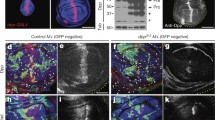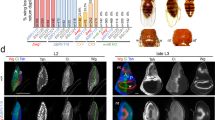Abstract
IN this paper we show for the first time that the developmental capacity of imaginal disk cells from Drosophila can be altered by appropriate grafting operations. The appendages of amphibians and immature arthropods, and the imaginal disks of holometabolous insects, are capable of undergoing pattern regulation when parts are removed. (Pattern regulation is used here to describe the alteration of cell fates in response to an abnormal situation in a developing system; we include under this term both regeneration and duplication.) Regulation then occurs during growth of the tissue by cell division, a process termed epimorphosis1. A characteristic feature of epimorphic regulation which has recently been recognised, is the different regulative responses shown by complementary pieces. For example when an imaginal disk of Drosophila is bisected and allowed to grow for some time, one of the two fragments usually regenerates the missing parts, while the other undergoes duplication of the presumptive pattern already present2. Similarly, whereas the stump of an amputated amphibian or cockroach limb can regenerate distally, the amputated distal part, if kept alive by grafting to a host animal, can also undergo pattern regulation by forming the distal pattern elements, thereby duplicating itself3–6.
Similar content being viewed by others
References
Wolpert, L., Curr. Top. dev. Biol., 6, 183–224 (1971).
Bryant, P. J., Ciba Symp., 29, 71–93 (1975).
Butler, E. G., J. Morph., 96, 265–281 (1955).
Dent, J. N., Anat. Rec., 118, 841–856 (1954).
Bohn, H., Wilhelm Roux Arch. Entw. Mech. Org., 156, 449–503 (1965).
Bulliére, D., J. Embryol. exp. Morph., 23, 323–335 (1970).
Rose, S. M., Symp. Dev. Growth, 20, 153–176 (1962).
Bohn, H., Wilhelm Roux Arch. Entw. Mech. Org., 167, 209–221 (1971).
Bulliére, D., Devl Biol., 25, 672–709 (1971).
Shaw, V. K., and Bryant, P. J., Devl Biol., 45, 187–191 (1975).
Iten, L. E., and Bryant, S. V., Devl Biol., 44, 119–147 (1975).
Sengel, P., Ciba Symp., 29, 119–121 (1975).
Bryant, P. J., J. exp. Zool., 193, 49–78 (1975).
Schubiger, G., Devl Biol., 26, 277–295 (1971).
Garcia-Bellido, A., Ripoll, P., and Morata, G., Nature new Biol., 245, 251–253 (1973).
Ursprung, H., and Hadorn, E., Devl Biol., 4, 40–66 (1962).
Garcia-Bellido, A., Devl Biol., 14, 278–306 (1966).
Poodry, C. A., Bryant, P. J., and Schneiderman, H. A., Devl Biol., 26, 464–477 (1971).
Bryant, P. J., Devl Biol., 22, 389–411 (1970).
Garcia-Bellido, A., and Merriam, J. R., Devl Biol., 24, 61–87 (1971).
Author information
Authors and Affiliations
Rights and permissions
About this article
Cite this article
HAYNIE, J., BRYANT, P. Intercalary regeneration in imaginal wing disk of Drosophila melanogaster. Nature 259, 659–662 (1976). https://doi.org/10.1038/259659b0
Received:
Accepted:
Issue Date:
DOI: https://doi.org/10.1038/259659b0
- Springer Nature Limited
This article is cited by
-
The PERK pathway independently triggers apoptosis and a Rac1/Slpr/JNK/Dilp8 signaling favoring tissue homeostasis in a chronic ER stress Drosophila model
Cell Death & Disease (2014)
-
Transduction of mechanical and cytoskeletal cues by YAP and TAZ
Nature Reviews Molecular Cell Biology (2012)
-
Apoptotic and Non-apoptotic Caspase Functions in Neural Development
Neurochemical Research (2011)
-
Pattern regulation during the development of the dorsal abdomen in the flesh fly, Sarcophaga agryostoma
Roux's Archives of Developmental Biology (1991)
-
Changes in the distribution of gap junctions inDrosophila melanogaster wing discs during the third larval and early pupal stages of development
Wilhelm Roux's Archives of Developmental Biology (1984)





